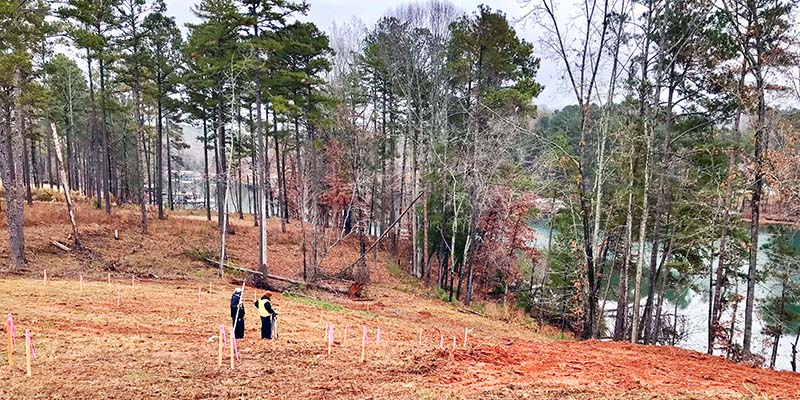Analyzing a lot for construction is the next step in the process now that you’ve found the lakefront property on which you’d like to build your home. Before starting the work on a building plan, we will research your chosen build site since the condition of the land will affect your overall design and the cost to build your home. An experienced builder won’t draw architectural plans for you without a detailed site plan and should never offer an estimate of construction costs without knowing the details of the land itself.
As we outlined in Part 2: Find a Waterfront Home Site, Total Quality Home Builder’s waterfront property specialists will meet with you to walk the lot. Together, we’ll work to understand your vision and decide on the best spot on the lot for your home. We’ll assess the topography, determine the ideal placement and view, establish the locations of the driveway and septic system, and offer suggestions and estimates for proposed building costs for a Good Faith Estimate.

The Natural Beauty of Lake Keowee
Taking note of the natural elements of your lakefront property, we’ll consider the following details as we’re analyzing the lot for construction: rock outcroppings, low areas and slopes, water elements, high points and ridgelines, forms and unique natural features, waterfront views, and mountain vistas. Incorporating these existing features of the lot into the site plan will help us provide you with a lake home that takes advantage of the natural beauty of Lake Keowee.
As we analyze the lot, we consider everything from tree locations to sun orientation, topography, potential views, natural breezeways, and orientation to the lake. As the site plan is being developed, we make sure to use the site’s opportunities, to take advantage of the site’s views, sunlight, and energy efficiency opportunities.

Things to Consider When Evaluating a Building Site
Taking the time to properly analyze and evaluate a build site, we’ll be able to develop the best site plan for the lot and ultimately, for your lake house. Our specialists will design a home that suits that land and takes advantage of all it has to offer. Here are some of the most important things we’ll consider when we start the process of analyzing a lot for construction.
- Property lines show the legal limits of the property that you legally own. You may see stakes placed at the corners of the property. These boundaries will also show on the plat that you receive when purchasing a piece of property.
- Building setback lines are established by the local jurisdiction’s zoning regulations and will indicate the required front, rear, and side areas of the property where a building can’t be built.
- Easements are additional defined areas where building legally can’t be done. These are areas where utilities or access lanes are typically located.
- We’ll note the orientation of the property as it relates to a compass. Does the property face north, south, east, or west?
- We’ll document where the sun rises and sets in winter and summer. We’ll take note of where the sun is at midday as this will help determine the best orientation for rooms and windows. This will affect the brightness of your home and its energy efficiency.
- As we’re analyzing the lot for construction, we’ll document areas of moderate and steep slopes, if any. Moderate slopes can be opportunities to create
- walk-out basements and can be incorporated into the design of the home.
- Locating significant trees and natural areas that you want to preserve is important and will help us place the home in a position to take advantage of the natural beauty of your property.
- Site features such as the location of boulders, drainage swales, creeks, and other features you want to avoid or integrate into your design.
- Knowing the direction you and your visitors will enter and exit the property will help us design a house that feels right on the land.
- Take note of the direction of views you would like to incorporate into the layout of the home. Do you want to see the lake from the living room or the kitchen? Or both?
- It’s important to note the locations of neighboring structures to plan for optimizing your privacy and your neighbors’ privacy.
- As we are analyzing a lot for construction, we’ll naturally uncover ideal spots for your home. We’ll make note of and discuss these options with you.
- Community restrictions, as outlined in HOAs, and local zoning may set height limits, area limits, lot coverage restrictions, or other rules that will influence your design.

City, County, and State Regulations
Every city, county, and state has its own unique building and excavating regulations and it’s important that your builder is well-versed in the area you are building your home. As a builder is analyzing a lot for construction, knowledge of local regulations and HOA ordinances is a must. The development approval process varies from place to place, and many require several layers of local, state, and federal permits and approvals. Be sure you’ve chosen a builder that understands this process to avoid delays and the unintended breaking of area regulations.
The main purpose of these restrictions is to ensure the proper development of land for which it is zoned and to protect other property owners from improper development and use of surrounding lots that may affect the value of the properties in the area. Regulations also secure and maintain proper setbacks from streets and adequate open spaces between structures. In general, they also provide for and ensure the quality of the property in an aesthetically pleasing manner and in accordance with all local ordinances and requirements for Lake Keowee developments in Pickens County and Oconee County.
In our next installment, Part 4: Land Survey, we’ll discuss the land survey, which is required by the South Carolina Department of Health and Environmental Control (DHEC) for the septic systems and is required by the county for a building permit. Since lakefront lots rarely have flat land, a topographical survey may be ordered depending on the grade of the site. These surveys will assist in determining excavation estimates and a better determination of the overall cost when working on your Good Faith Estimate.

 2022
2022
 Total Quality Home Builders 2022
Total Quality Home Builders 2022